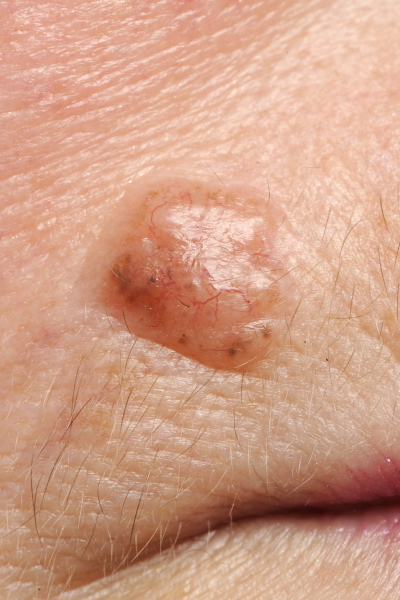BCCs are slow growing and don’t spread to other parts of the body, they occur most frequently on the sun-exposed areas of the head and neck.

Features of Basal Cell Carcinomas include:
- Smooth lump
- Pearly or shiny appearance
- Slow growing
- Typically develop a crust or scab which eventually falls off but recurs
- Sometimes bleeds
- Never completely heals
- Develop into a painless ulcer
What causes a basal cell carcinoma?
Patients with fair skin types are most likely to develop a BCC and the risk is significantly increased by exposure to sunlight. This exposure may have occurred many years before the development of a BCC. They are commonly seen in patients that have had an outdoor job, lived overseas, or those that enjoy gardening and outdoor sport such as golf or cricket. Rarely, they are linked to arsenic exposure, burns or scars.
Why do they need to be treated?
Without treatment, basal cell carcinomas will continue to grow in the skin and will cause disfigurement of surrounding tissues. They only very rarely spread to other organs of the body and are not generally considered to be life-threatening. Nevertheless, early treatment is advised to avoid further problems.
What treatment is usually advised?
BCCs can be successfully treated and cured. Treatment options are surgical and non-surgical depending on the type, size and location of the BCC. Your doctor will advise you on the most appropriate treatment for you.
Some of the treatments we offer are:
- Cryotherapy (freezing with liquid nitrogen) and curettage (scraping) for early, very small or superficial basal cell cancers
- Surgical excision, including complex repairs with skin flap and skin grafts
- Mohs Micrographic surgery – a specialist treatment for complex, extensive or poorly-defined BCCs on the head &neck; available only in a few UK centres
- Photodynamic Light treatment (PDT)
Skin Surgery
This is normally carried out as a day-case procedure under local anaesthetic. You will be asked to consent to a small operation to remove the skin lesion with stitches. A small margin (3-4mm) of normal skin is removed around the main lesion and this is sent to a pathologist who will then check the diagnosis and assess whether removal has been complete. A report is usually issued within two weeks of treatment and you should receive a letter confirming that the removal has been successful.
Will further treatment be required on a longer-term basis?
Patients treated with skin surgery are generally discharged once a report has been issued suggesting complete removal of the BCC. Patients treated by alternative methods, will usually be followed up in clinic.
Will I develop more skin cancers?
Once you have had one BCC your risk of developing a further BCC within the next 5 years is around 30%, if you have had multiple BCC’s previously then your risk is higher. It is therefore important that you examine your skin regularly and if you are concerned about a new skin lesion you can make an appointment to see one of our Consultant Dermatologists for a prompt diagnosis and any necessary treatment. Appointments can be made directly without a GP referral.
How can I help myself?
The best method of prevention of any type of skin cancer is to stay out of the sun and if you do need to go out, keep covered up with a wide brimmed hat, long-sleeved shirt or blouse and long trousers. Wear a high protection factor sunscreen on exposed skin any time you go out of doors even on overcast days. Many companies now make skin moisturisers with a factor SpF 15 or above and you may want to build this into your daily routine.
